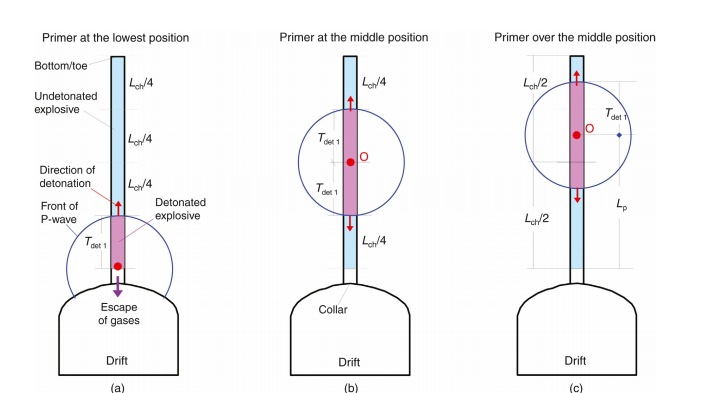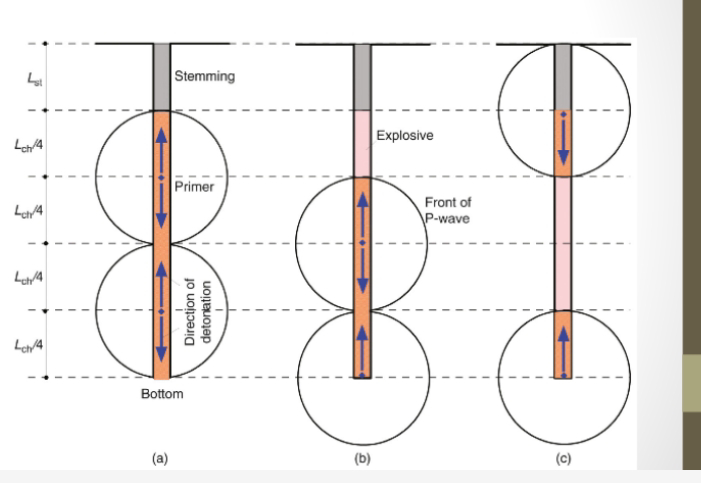MISFIRE: IT'S CONTROL, HANDLING AND PRECAUTIONS
BY GIANT MINER
A FRESH GRADUATE STUDENT OF FEDERAL UNIVERSITY OF TECHNOLOGY AKURE, MINING ENGINEERING DEPARTMENT.
Buttressing all known definitions, Misfire is the incomplete or partial failure of a Blasting charge to detonate/explode as planned.I like to retorate that, Misfire is not limited to charge failure at initiation, but also extend to accidental detonation of Explosive and other Blasting accessories.
modified after Australia mine Since misfire is a very hazardous, every reasonable means available to site manager must be taken to avoid it occurrence.
Let Begin the journey by understanding how to recognize misfire;
After firing, a proper checking of face and muckpile must be done to ensure that there is no indication of misfire. The occurrence of misfire during Blasting result into the following blast challenges:
1. Production of Noxious (NOx gas) fumes and toxic dust,
2. Inadequate ground movement,
3. Poor fragmentation,
4. Unusual blast sounds or vibration rate,
5. Flyrock,
6. Evidence of undetonated Explosive in bench face or in muckpile,
These are the Conditions a Blasting Engineer can use during blast to at least predict if there is misfire or not.
The occurrence of misfire (now during Blasting) is a bit dangerous but the post blast effect is the main problem.
How can this six (6) signs occur and why does it occurred?
Site Misfire Indicator
Production of Noxious fumes and toxic gases is as a result of alteration in the Explosive oxygen balance due to incomplete detonation. As we all know, oxygen balance is very important.
It dictate the type of gas, time and dust produce from Explosive at detonation.
Each Explosive has been tested at production and all gases reacting with oxygen had been balance in such a way that, at detonation, only those gases that are not poisonous are released.
Incomplete or partial detonation of Explosive led to negative oxygen balance.
This final cause the complete production of Noxious fumes which is hazardous. This is a good indicator to identifying misfire from the generated gases from Blasting.
As a Blasting Engineer, it clear that Blasting 100 charge holes will generate more ground movement than 70 charge holes. As the charge density will be different. The production of less ground movement from large charge can be use as indicator of blast misfire.
Also, poor fragmentation result from misfire. During Blasting, failure of two or more holes affect burden movement. It create more oversize and poor fragmentation.
post Blasting inspection of misfire
Inspection of misfire after Blasting is a dangerous task. In all circumstances this must be done in accordance with site rules.
Hazard exist not only from the remaining undetonated Explosive but also from the post blast environment. Due to the present of toxic fumes. It is possible that misfire Explosive detonates after some time, therefore it is essential that adequate trained personnel should regularly check the muckpile and face during loading operation. Unchecked misfire is very dangerous, when such is load and transport to the processing plant can detonate during crushing.
From various study by different researchers, there are four initiation stimuli that cause explosion Detonation, this is place under this acronyms:
FISH:
F: Friction,
I: Impact,
S: shock and
H: heat
The present of any of this four result in the initiation of Explosive.
Impact during crushing can initiate undetonated Explosive in Boulder socket.
PROCEDURE ACTION ON SITE
The extent and nature of misfire must be determined after identification. This must be done as soon as possible after the misfire has been identified.
After check and clear: The *All Clear* sign should be given.
But if not yet clear the dangerous zone must be barecad
How to deal with identified misfire
Now after we have done our post Blasting inspection and confirm the occurrence of misfire. These are some ways to deal with identified misfire undetonated charge hole;
A. Removing stemming and re-priming: These are some precautions to observe when removing the stemming materi.
1. When the detonator is close to the undetonated Explosive, stemming removing with force should not be attempt,
2.In case of electric detonator the use of high velocity air should not be attempted as it can generate static charges sufficient to initiate electric detonator
3. Bulk Explosive can be washed out of misfired shotholes.
4. special care must be taken in removing the cartridge expecially where detonators are involved
5. Under no circumstances should Explosives or detonator be removed from a drill hole by pulling on the detonating cord or detonator lead
6. Use suitable extracting tools if required.
Some of the advantage of using high pressure water to flush Explosive during misfire include;
1. It desensitise any non water proof Explosive and dissolve high concentration of water soluble Explosive ingredients
2. It overcome the mechanical lock of stemming material comprising chippings
Other ways of dealing with misfire is by
B.Drilling and firing relieving holes:
The objective of drilling the relieving hole is to blast Explosive we are unable to remove. Also, to disturb and displace the adjacent Explosive column. Also, to break up the rock mass in the region of misfire explosive to remove undetonated Explosive.
Precautions to be taken in drilling the relieving holes include;
1. The hole burden and spacing depend on the sensitivity of the Explosive, the inclination of the misfire hole and the diameter of the hole.
2.The relieving hole must be parallel to the misfire hole and be of the Same depth.
Relighting of a misfire safety fuse is highly prohibited and dangerous
Also, We should give enough time before going to the misfire site.
This is because the blast charge can reinitiate with time. More than one hour is not even enough!
Also, charging when raining is prohibited and can cause misfire.
Check Explosive before use, Blasting environment must be inspected before selection of Explosive.
Use of non water proof Explosive in water log environment is bad. Because, as it has been damaged earlier, the Explosive material in it might have been deteriorated or infected which can lead to fire breakage at ignition.
CONTRIBUTION FROM ENGR. MOSHEN JENA
AEL Explosive and Blasting Engineer (Zimbabwe)
Indications of a misfire
- Inadequate ground movement.
- Undisturbed ground
- Lack of fracturing
- Poor fragmentation in areas of shot
- Evidence of undetonated explosives
- Hang-ups on face
- Unusual blast sound
When you see that there is inadequate ground movement. obviously there is expected movement and when you see it falling short of what you expectected then there are high chances that there is a misfire
Causes of Misfires
Technical failure
- Wrong primer/assembly
- Circuit connection/coupling fault
- Detonator/poor explosive coupling
- Unsuitable explosives
- Carelessness – damage to initiation systems
- Wrong equipment, e.g. exploder
- Equipment failure
-Exploder (not serviced)
-Circuit tester
-Firing cables
Site conditions
Weak ground/movement
Water presence
Geological discontinuities – cut offs
Product failure
Detonating cord – gaps
Detonators – Faulty fuse head/delay
Shock tube – moisture ingress/connection block
Fuses – Moisture; poor crimping; damage
Explosives – water ingress; static pressure; decoupling
Misfire implications (Safety)
-Unexploded explosives and or Unexploded initiation systems
-Unstable/sensitised explosives
- Accidental detonation
-Drilling into misfires (no drilling into sockets)
-Struck by LHDs
-Run over by trucks/wheels
-In crushers
-On feeders/screens
-Deposited onto dumps
-Taken off site in tippers
*Re-entry into a misfired area*
- Where the blast fired successfully all gases and dust must be allowed to clear before re-entry or inspection.
- Where multi-blast conditions exist the following guidelines must be adhered to:
A re-entry of 30minutes must be allowed after blasting.
Where the initiator of the blast failed a re-entry period of 30 minutes must be allowed where pyrotechnic systems are used and 5 minutes for electronics.
*Treatment of misfires*
Early shift examination
-Mark the hole (MF).
-Return the fuse, shock tube or downlines wire into the hole.
-Plug the hole with a socket plug.
- Barricade the area off with appropriate warning signs.
During the shift
-Remove the socket plug.
-If ANFEX or Emulsion, flush hole with water.
-If Cartridges, pull out with an approved scraper and wash out with water.
Remove cartridges and detonators in separate containers to old explosives boxes for destruction in a designated area.
Misfire Safety
- Never attempt to pull a misfire with force out of a hole or muckpile.
- In the case of shock tube, the tube snap and shoot and the column charge can go off.
-In the case where the detonator is damaged to the extend that the explosives charges in the detonator are exposed, friction especially with grid in the hole, could cause accidental initiation.
-Always remember that detonators in a misfired hole have been exposed to extreme external forces during the blast. This means that a detonator retrieved from a misfired hole is not in the state of the original manufacturing and could be potentially more sensitive.
*Reporting Misfires*
- Potentially the most hazardous situation to have to deal with is misfires.
*AVOID!!!!!!!*
Correct blast designs
Appropriate initiation systems
Always report misfires to the responsible Miner.
Always report misfires to the relieving shift.
in parting let me share with you incidents that have happened elsewhere
Remember, and *An accident is a total loss, unless we learn something from it* A crusher attended was severely injured when undetonated explosives in the ore were hit by the crusher jaws resulting in accidental detonation of explosives. The injured was rushed to the hospital but died upon admission at the referral hospital. An LHD driver was luck to survive, after he was hit by flyrock ejected from accidental detonation when his bucket hit primed explosives whilst lashing. He sustained serious injuries but was saved by the screens on the LHD operators cab.
A drill rig operator died after drilling into a misfire. The drill steel hit the misfired explosive and it went off. The operator sustained multiple fractures and the rig was also written off. We have deliberately removed the names of the mines so that we get learn from the incident without worrying about who did it. Whilst trying to pull a shock tube that had been reverse primed, there was accidental detonation. This resulted in a violent explosion that ripped the face of the charging assistant and he died instantly. An excavator hit a misfires and the explosion damaged the bucket of the excavator and shattered all the windows.
GIANT MINER General Conclusion
Since to prevent risk which is the father of accident is greatly important, proper steps must be taken to curb any occurrence of misfire during Blasting. In addition, Explosive is a very dangerous chemical substance, is as good as proper handling, if out of hand can be highly disastrous. Furthermore, Handle all Explosive related operations with great care and consideration. Following all needful precautions and safety policy.
Nigeria as a case study been a country with many large scaleime, small scale and artisanal mine need wide teachings and training about misfire. Most local blasters have less knowledge about this and had fall victim of such incident.
Make your country mine sector great by making it safe.
Thanks
Love you all
Still your GIANT MINER











